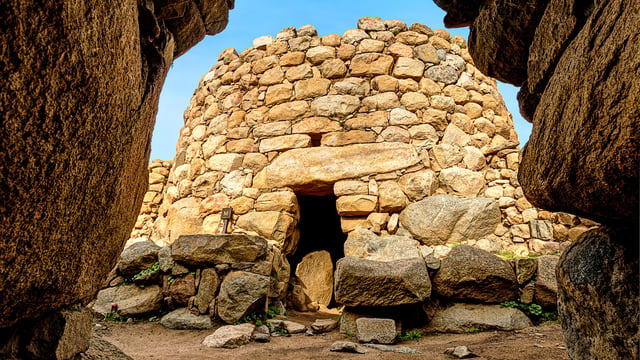Ultimate Nuragic Itinerary of Sardinia
The archaeology of the Nuragic Culture is unique to Sardinia, and not surprisingly a major tourist attraction. From the displays in the National Archaeological Museum in Cagliari to the stone sculptured Giant’s in Cabras. Nuraghe from Arrubiu to Barumini. Sacred wells and Giant’s Tombs. You could spend a great deal of time travelling the length and breadth of the island seeing this extraordinary prehistoric heritage. We present the ultimate itinerary of Nuragic Civilisation, a self-guide tour of seven days from Cagliari to Olbia.
Must See Nuragic Sites & Museums in Sardinia
National Archaeological Museum, Cagliari
Given the quantity of objects from all over the island, this museum is certainly the most important in Sardinia. Since 1993 it has occupied one of the buildings in a complex known as the ‘Citadel of Museums’, built within the district of Castello, reusing the space of the ancient medieval walls. It houses more than 4,000 objects that tell 7,000 years of history, ranging from Prehistory to the Early Middle Ages, in an itinerary that is divided over 4 floors, each with different themes. In the collections visitors can admire statuettes of the mother goddesses, Nuragic bronze statues, a large part of the Nuragic giant statues of Mont’e Prama, as well as Punic and Phoenician jewellery and Roman statuary.

Nuraghe Arrubiu, Orroli
Taking its name from the reddish lichen that covers the rocks that make up the ruins, Nuraghe Arrubiu is thought to be the largest surviving nuraghe in Sardinia. The central tower is estimated to have been between 25 and 30 m in height. In all there were 21 towers, and the complex covered an area of about 3,000 square metres. It was built towards the end of the 14th century BC, when the island had considerable contacts with eastern Mediterranean lands, particularly Cyprus and Mycenae. The settlement was abandoned and collapsed around the 9th century BC.


The Nuragic Sanctuary of Santa Vittoria
Located on a plateau with expansive views of the surrounding area. It is the largest Nuragic village/sanctuary complex in Sardinia, where what remains of the structures, even thousands of years later, manages to express the power and importance of the site. The area that can be visited is large, consisting of several parts. The oldest of which is a proto-nuraghe dating between the 17th and 14th centuries BC. During a pleasant walk, visitors can explore the remains of the village, in which the huge dimensions of the meeting hut, the sacred well, and the large festival enclosure that once housed pilgrims during festivals in honour of the deity stand out.

Su Nuraxi di Barumini
Undoubtedly one of the best-known and best-valued sites on the island, and represents the highest expression of the Nuragic civilisation. The nuraghe, consisting of four towers arranged around a central one, together with an extensive village surrounding it, was uncovered in 1950. The entire complex dates between the 16th and the 6th centuries BC. It is only possible to visit the site by taking a guided tour. An expert guide will take you on a tour of the main features of the settlement and through the narrow passages of the nuraghe, and introduce you to the Nuragic civilisation.

Civic Archaeological Museum of Cabras
The Museo Civico “Giovanni Marongiu” – Cabras opened in 1997 exhibiting the local history of the Cabras municipality (including the Sinis Peninsular), from prehistory to medieval times. Artefacts come from Neolithic, Nuragic, Phoenician-Punic, Roman and medieval sites in the area. Two notable displays include the Roman shipwreck of Mal di Ventre, dated to the 1st century BC, and a small collection of the large stone statues, the ‘Sardinian Giants’, recovered by archaeologists at the Nuragic necropolis of Mont’e Prama.

Mont'e Prama Archaeological Site
The archaeological site at which the fragments of the so-called Giants of Mont’e Prama were found is not open to the public. Although you can see the excavation from the road. This is because archaeological investigations are ongoing. Regular events are organised, however, either by the museum in Cabras or the Mont’e Prama Foundation. And these often include guided tours of the site. These last about an hour, and we highly recommend taking one if you can. Although it seems that there is very little to see (certainly there are not giant sculptures in place), it is possible to get an appreciation of the ritual context of the larger than life sculptures.

Nuraghe la Prisgiona
Nuraghe La Prisgiona in the Capichera valley, is located near the town of Arzachena and the popular tourist coastal area of Costa Smeralda. It comprises a large nuraghe (tower) surrounded by a settlement that once covered an area of 5 hectares. The nuraghe consists of a central keep and two side towers. This particular settlement was inhabited between the 14th – 9th centuries BC. And there is also evidence that the settlement may have been occupied during Roman and medieval times. Excavations have revealed over 90 circular stone huts connected connected to each other by paved walkways.











